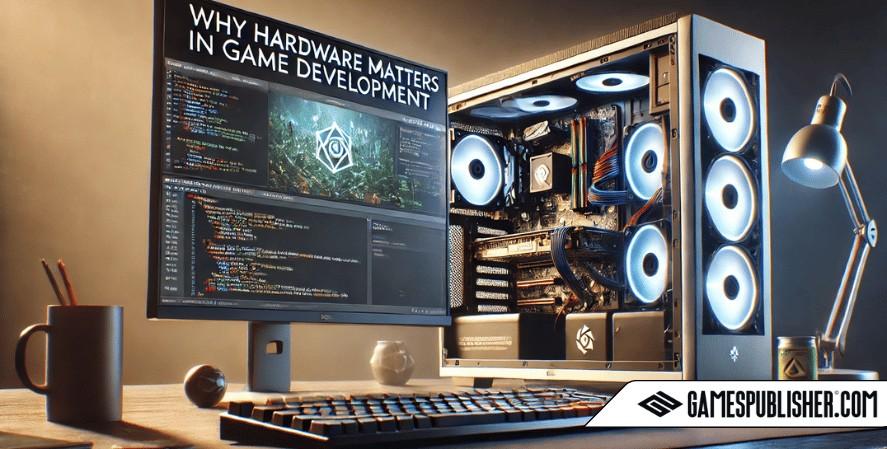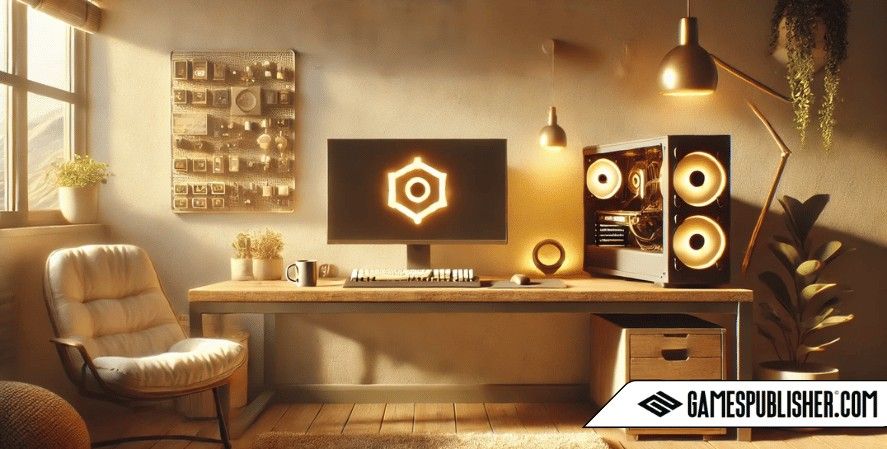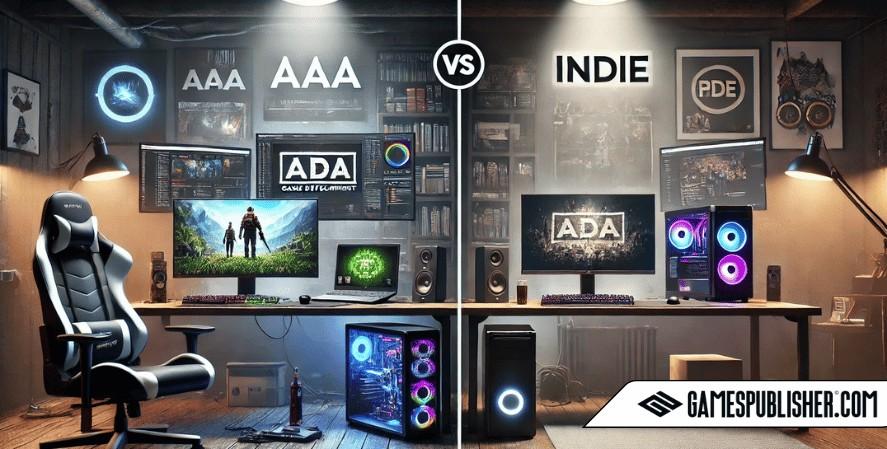Welcome to Gamespublisher.com! If you’re getting started with game development, whether for Indie or AAA projects, having the right hardware setup is crucial. But with so many options, how do you know what’s best for your needs?
This guide will explain the differences between building PCs for AAA and Indie game development. We’ll cover everything from key hardware requirements to cost-effective PC builds for game creators.
1. Why Hardware Matters in Game Development

Choosing the right PC setup isn’t just about having the most powerful machine. It’s about making your workflow smoother and boosting your productivity. Depending on the type of game you want to create, your hardware needs will vary a lot.
- AAA game development involves big teams, complex projects, and high-end graphics. These games need strong CPUs, powerful GPUs, and lots of RAM to handle huge amounts of data and real-time rendering.
- Indie game development is often more budget-friendly and focuses on creativity rather than realistic graphics. Indie projects can be built on mid-range hardware, which costs less.
In this guide, we’ll look at what kind of PC setup works best for each type of development and help you decide if a pre-built or custom PC is the better option.
2. Understanding AAA vs. Indie Game Development
What Is AAA Game Development?
AAA games are high-budget titles made by big studios. They have huge development teams and use advanced graphics. Think of games like Call of Duty or Assassin’s Creed. These games use powerful hardware to create:
Because of these demands, AAA game development needs very strong PCs.
What Is Indie Game Development?
Indie games are smaller projects made by small teams or even solo developers. They don’t always focus on high-end graphics. Instead, they emphasize creativity, storytelling, and innovative gameplay.
Indie games are cheaper to make and don’t need extremely powerful hardware. Examples include Hollow Knight or Celeste. For most indie games, a mid-tier PC will work just fine.
3. Key Hardware Requirements for AAA Game Development

To make AAA games, you’ll need top-tier components. Here’s a breakdown of what each part should look like:
High-End CPU for Intensive Tasks
A strong CPU is essential for AAA games. These games have complex code, real-time physics, and advanced AI, so your processor needs to keep up.
- Recommended: Intel Core i9 or AMD Ryzen 9.
- Why? These CPUs have many cores, which handle complex tasks faster.
Powerful GPUs for Graphics Rendering
AAA games have detailed graphics and real-time effects, like ray tracing. This makes a high-end GPU a must.
- Recommended: NVIDIA RTX 4080 or AMD Radeon RX 7900 XT.
- Why? These GPUs can handle high-resolution graphics and smooth rendering.
Memory (RAM) Considerations
You’ll need a lot of RAM for multitasking and managing large projects.
- Recommended: 32 GB or more.
- Why? This amount is good for keeping multiple programs running without lag.
Fast Storage (SSD vs. HDD)
AAA games have big assets, so a fast storage drive will help with loading times and saving data.
- Recommended: NVMe SSD (1 TB or more).
- Why? NVMe SSDs read and write data much faster than traditional HDDs.
Peripherals and Displays
A good display setup is important for accurate testing. You’ll also need ergonomic peripherals to stay comfortable.
- Recommended: Two 4K monitors and a quality keyboard.
- Why? Dual monitors help with multitasking, and 4K resolution is great for seeing fine details.
4. Key Hardware Requirements for Indie Game Development

Indie game developers don’t usually need as much raw power. Here’s what you should aim for:
Moderate CPU for Basic Game Logic
Most indie games don’t need high-end CPUs. You just need something that can handle scripting and light calculations.
- Recommended: Intel Core i5 or AMD Ryzen 5.
- Why? These CPUs are good for general development without the high cost.
Mid-Tier GPU for 2D/3D Graphics
A mid-range GPU will be enough unless your game has heavy 3D graphics.
- Recommended: NVIDIA GTX 1660 Super or RTX 3060.
- Why? These GPUs are affordable and handle basic 3D work well.
Memory (RAM) Requirements
Most Indie games have smaller projects, so 16 GB of RAM is usually enough.
- Recommended: 16 GB RAM.
- Why? This is more than enough for game engines and light 3D work.
Storage Considerations
You can use a standard SATA SSD instead of an expensive NVMe drive.
- Recommended: 512 GB or higher SATA SSD.
- Why? It offers faster load times than HDDs at a lower price than NVMe.
Peripherals and Displays
Most Indie developers can work with one or two HD monitors and basic peripherals.
- Recommended: One or two Full HD monitors.
- Why? HD monitors are good for most design work, and multiple screens help with multitasking.
5. Performance Needs for Different Development Tools
Game Engines and Software
Your choice of game engine will affect what kind of hardware you need:
- Unity: Works well with mid-range setups and can handle both 2D and 3D games.
- Unreal Engine: Needs more GPU power for real-time lighting and complex visuals.
- Godot and GameMaker: Lightweight engines that run smoothly on almost any modern PC.
Testing and Debugging Requirements
AAA games need to be tested on high-end systems and multiple platforms. Indie games usually target one platform, so a simpler setup works.
Asset Management and Pipeline Efficiency
AAA teams use large-scale tools that need powerful PCs. Indie teams often use smaller, more manual tools, which don’t need as much power.
6. Should You Have Different PCs for AAA vs. Indie Development?

For serious AAA development, you’ll need a high-end setup. But for Indie development, you can get away with a more budget-friendly machine. It’s a good idea to have a mid-range PC that you can upgrade as your project grows. This way, you’re prepared for more demanding projects in the future.
7. Recommendations for Building or Buying a Development PC
Ideal Configurations for AAA Game Development:
- CPU: Intel i9-13900K or AMD Ryzen 9 7950X.
- GPU: NVIDIA RTX 4080 or AMD Radeon RX 7900 XT.
- RAM: 64 GB DDR4/DDR5.
- Storage: 2 TB NVMe SSD.
Ideal Configurations for Indie Game Development:
- CPU: Intel i5-12600K or AMD Ryzen 5 5600X.
- GPU: RTX 3060 or RX 6600 XT Equivalent.
- RAM: 16 GB DDR4.
- Storage: 1 TB SATA SSD.
8. Conclusion
Choosing the right PC depends on your project size, needs, and budget. For AAA development, a high-end build is worth the investment. For Indie work, a good mid-range PC will be enough. Be sure to pick parts that suit your current needs, but leave room for upgrades if you plan to work on bigger projects in the future. For more detailed guides and expert advice, check out more resources at Gamespublisher.com!
Loading survey...

